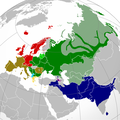Slika:Indo-European branches map.png

Velikost tega predogleda: 599 × 600 točk. Druge ločljivosti: 240 × 240 točk | 479 × 480 točk | 767 × 768 točk | 1.023 × 1.024 točk | 2.045 × 2.048 točk | 2.934 × 2.938 točk.
Izvorna datoteka (2.934 × 2.938 točk, velikost datoteke: 2,16 MB, MIME-vrsta: image/png)
Zgodovina datoteke
Kliknite datum in čas za ogled datoteke, ki je bila takrat naložena.
| Datum in čas | Sličica | Velikost | Uporabnik | Komentar | |
|---|---|---|---|---|---|
| trenutno | 05:43, 26. september 2022 |  | 2.934 × 2.938 (2,16 MB) | Alexikoua | minor fixes |
| 17:58, 30. marec 2022 |  | 2.934 × 2.938 (1,74 MB) | Whoop whoop pull up | Whoops, wrong file! | |
| 17:37, 30. marec 2022 |  | 2.048 × 2.048 (980 KB) | Whoop whoop pull up | Misc fixes (Russian minority in Svalbard & Israel, Slovenian in SE Carinthia, Greek in N Epirus, Aromanians/Megleno-Romanians, Swedish essentially extinct in Estonia, etc. | |
| 11:37, 22. december 2021 |  | 2.934 × 2.938 (1,74 MB) | Ahmet Q. | Reverted to version as of 19:55, 23 August 2021 (UTC)seek consensus for your changes | |
| 22:40, 25. november 2021 |  | 2.934 × 2.938 (2,16 MB) | Alexikoua | rv elimination of Greek minority in Albania | |
| 21:55, 23. avgust 2021 |  | 2.934 × 2.938 (1,74 MB) | Ahmet Q. | Rv false edit summary. Overrepresentation of Greeks in Turkey, Albania and Ukraine. Unexplained removal of Romanian in Serbia. Overall deterioration of the original file. Seek consensus for your changes. | |
| 18:16, 7. avgust 2021 |  | 2.934 × 2.938 (2,16 MB) | Demetrios1993 | Addition of Arbereshe linguistic minority in Sicily. Addition of Serbian, Bosnian, and Gorani linguistic minorities in Kosovo. Addition of Greek linguistic minorities in Italy, Albania, Turkey, and Ukraine. Including some other minor corrections. | |
| 19:00, 19. november 2020 |  | 2.934 × 2.938 (1,74 MB) | Golden | update Armenian | |
| 20:42, 31. marec 2018 |  | 1.479 × 1.479 (574 KB) | Maphobbyist | Removed area that exactly corresponds to the non-Indo European Lezgi linguistic area. | |
| 23:37, 6. september 2016 |  | 1.479 × 1.479 (620 KB) | Rob984 | Georgia and Azerbaijan aren't majority multilingual. Older generations speak Russian from the Soviet era but now English is taught mainly in place of Russian. More people speak English in Finland, yet that isn't coloured. Also corrections to Celtic are... |
Uporaba datoteke
Datoteka je del naslednjih 2 strani slovenske Wikipedije (strani drugih projektov niso navedene):
Globalna uporaba datoteke
To datoteko uporabljajo tudi naslednji vikiji:
- Uporaba na ast.wikipedia.org
- Uporaba na ban.wikipedia.org
- Uporaba na be-tarask.wikipedia.org
- Uporaba na be.wikipedia.org
- Uporaba na bg.wikipedia.org
- Uporaba na cs.wikipedia.org
- Uporaba na da.wikipedia.org
- Uporaba na de.wikipedia.org
- Uporaba na en.wikipedia.org
- Uporaba na en.wikiversity.org
- Uporaba na es.wikipedia.org
- Uporaba na et.wikipedia.org
- Uporaba na eu.wikipedia.org
- Uporaba na fa.wikipedia.org
- Uporaba na fi.wikipedia.org
- Uporaba na frr.wikipedia.org
- Uporaba na fr.wikipedia.org
- Uporaba na gl.wikipedia.org
- Uporaba na gu.wikipedia.org
- Uporaba na gv.wikipedia.org
- Uporaba na hak.wikipedia.org
- Uporaba na he.wikipedia.org
- Uporaba na hy.wikipedia.org
- Uporaba na hyw.wikipedia.org
- Uporaba na ilo.wikipedia.org
- Uporaba na incubator.wikimedia.org
- Uporaba na io.wikipedia.org
Oglejte si globalno uporabo te datoteke.



